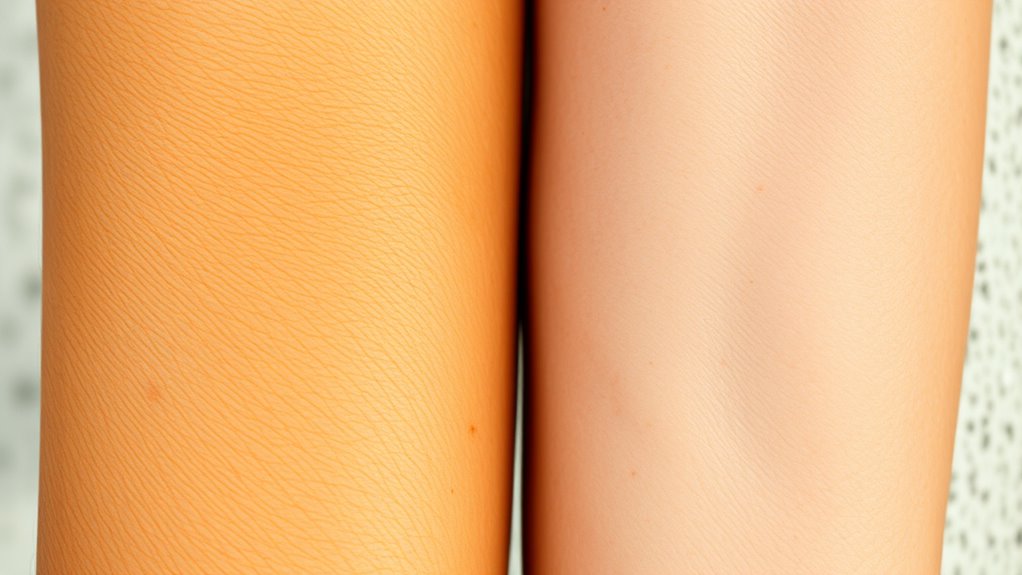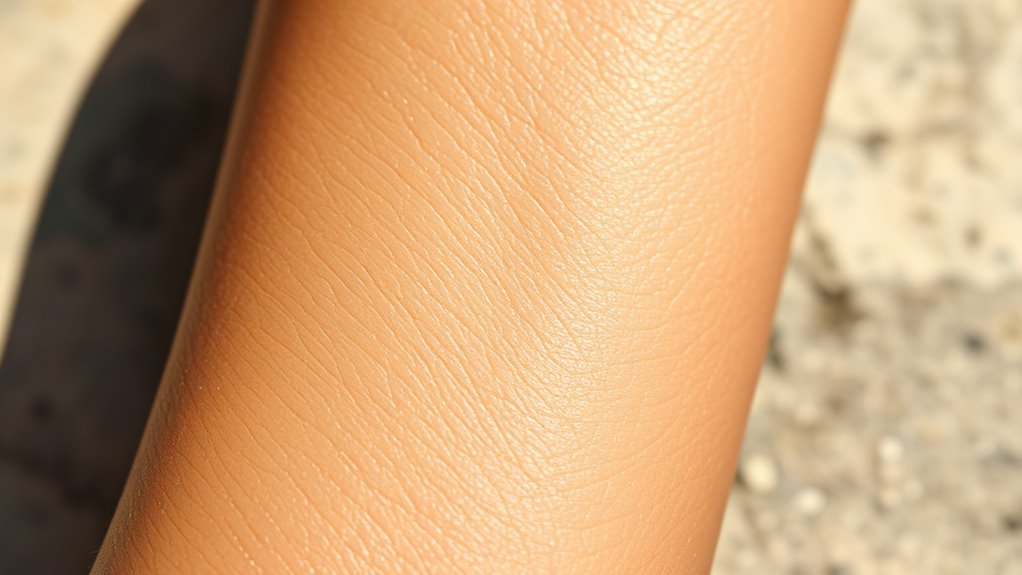Tanning damages your skin’s collagen fibers over time, speeding up the aging process. Repeated exposure to UV rays weakens and breaks down collagen, leading to wrinkles, sagging, and loss of firmness. This damage makes your skin less elastic and more prone to age spots and dullness. If you keep exposing your skin to the sun without protection, these effects will become more pronounced. Keep going to discover how to better protect your skin long-term.
Key Takeaways
- Tanned skin accelerates collagen breakdown, leading to wrinkles and loss of skin firmness over time.
- UV-induced collagen fragmentation causes skin sagging and a aged, less resilient appearance.
- Repeated tanning damages deep collagen fibers, impairing the skin’s natural elasticity.
- Long-term UV exposure weakens skin cells, reducing regenerative capacity and exacerbating aging signs.
- Protecting skin from UV rays helps preserve collagen integrity and prevents premature skin aging.

Tanned skin might look healthy and attractive, but it can have serious long-term consequences. When you spend time in the sun without protection, you’re exposing your skin to harmful ultraviolet (UV) rays that cause more than just a temporary change in color. Over time, this UV damage can accelerate skin aging and compromise the integrity of your skin’s collagen. Collagen is essential for maintaining skin elasticity and firmness, and when it breaks down prematurely, you start to see wrinkles, sagging, and a loss of youthful plumpness.
Every time you get a tan—whether from lying in the sun or using tanning beds—you’re damaging the deeper layers of your skin. UV rays penetrate beyond the surface, reaching into the dermis where collagen resides. This exposure triggers the production of free radicals, unstable molecules that attack collagen fibers and degrade their structure. As a result, your skin loses its ability to bounce back and stay firm over time. This process is what contributes to premature skin aging, making your skin look older than your actual age.
Tanning damages deep skin layers and accelerates aging by breaking down collagen fibers.
The more you tan, the more you accelerate this damaging cycle. Collagen fibers become fragmented and weakened, causing the skin to become loose and wrinkled. Fine lines emerge around your eyes and mouth, and the skin begins to sag, especially around the cheeks and jawline. Over years, these effects compound, transforming what might seem like a harmless tan into visible signs of aging. This isn’t just about appearance; the breakdown of collagen also hampers your skin’s ability to repair itself, leaving it more vulnerable to further damage from UV exposure.
Additionally, UV damage affects more than just collagen. It damages your skin cells and impairs their ability to regenerate, which speeds up the aging process. The cumulative effect of repeated UV exposure results in leathery, pigmented skin riddled with age spots and uneven tone. Without proper protection, your skin’s natural defenses weaken, and the long-term consequences become increasingly evident.
In essence, tanning might give you a short-term boost in confidence, but it comes at a high cost. Protecting your skin from UV damage by using sunscreen, seeking shade, and wearing protective clothing helps preserve your collagen and slow down skin aging. The sooner you adopt these habits, the better your skin will look and feel as you age. Remember, healthy skin isn’t just about appearance—it’s about safeguarding your long-term health and resilience against the visible effects of aging. Regular tent camping in natural environments can also remind us of the importance of protecting our skin from environmental hazards, both outdoors and in our daily lives.
Frequently Asked Questions
Can Tanning Cause Permanent Skin Discoloration or Uneven Pigmentation?
Yes, tanning can cause permanent skin discoloration or uneven pigmentation. Sun damage from UV exposure triggers excess melanin production, leading to dark spots or patches that may not fade over time. This uneven skin pigmentation results from sun damage, making your skin look mottled or discolored permanently. To prevent this, always protect your skin with broad-spectrum sunscreen and avoid excessive sun exposure, especially during peak hours.
Does Tanning Affect Collagen Production Differently With Natural Versus Artificial Sources?
Did you know that tanning, whether natural or artificial, reduces collagen production by up to 20%? You might think natural sun exposure affects your skin differently, but genetic factors influence how your skin regenerates after UV damage. Both sources accelerate collagen breakdown, leading to premature aging. So, regardless of the source, tanning hampers collagen, and protecting your skin helps maintain its youthful elasticity and overall health.
Are There Age-Related Differences in Collagen Damage From Tanning?
Yes, age-related collagen decline makes your skin more vulnerable to tanning and skin aging. When you’re younger, your skin’s natural repair processes help counteract damage, but as you age, collagen becomes less resilient. Tanning accelerates collagen breakdown, worsening the signs of aging. So, if you’re older, avoid excessive tanning to protect your skin’s collagen and maintain a youthful appearance longer.
How Does Tanning Influence Skin Elasticity Over Decades?
Tanning decreases your skin’s elasticity over decades by causing UV damage that breaks down collagen fibers. As your skin ages, its ability for skin regeneration slows, making it harder to repair this damage. Repeated UV exposure accelerates the loss of firmness and causes wrinkles. To protect your skin’s elasticity, limit tanning, wear sunscreen, and practice good skincare to support ongoing skin regeneration.
Can Collagen Repair Itself After Prolonged Tanning Exposure?
Think of your skin as a building’s foundation—once damaged, it struggles to fully repair itself. Collagen degradation from prolonged tanning can cause lasting harm, but your body does have some capacity for skin regeneration. While collagen can produce new fibers, extensive damage might limit this process. So, although some repair is possible, the effects of prolonged tanning often leave permanent marks on your skin’s youthful elasticity.
Conclusion
Tanned skin might look glamorous now, but every sunburn and golden glow chips away at your collagen like a relentless thief stealing your youthful firmness. Over time, the damage adds up, turning your skin into a fragile, crumbling masterpiece. Remember, your skin is your body’s largest organ—treat it with kindness before it becomes a map of regret. Protect it now, or risk losing that radiant glow to the unstoppable march of time.









